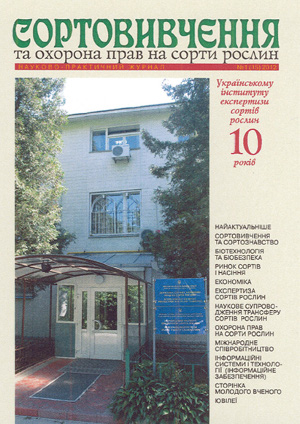The content of phenolic compounds in plant generative organs of cherry-plum and apricot varieties with different susceptibility to Sclerotinia (Monilinia) laxa
DOI:
https://doi.org/10.21498/2518-1017.1(15).2012.60186Keywords:
абрикос, алича, стійкість до Sclerotinia (Monilinia) laxa, фенольні сполуки.Abstract
The high content of phenolic compounds (quercetin-3-O-glycoside, izoramnetine-3-O-glycoside, 4'-metoxykempferol-3-O-glycoside, 4'-metoxyqvercetine-3-0-glycoside, apigenine and luteoline) in flowers of Prunus cerasifera Ehrh. in comparison with Prunus armeniaca L. has been shown. That can be the reason weak susceptibility of generative organs of cherry-plum to Sclerotinia (Monilinia) laxa (Aderh et Ruhl.) Honey.Downloads
References
Кудренко, I. К. Еколого-фізіологічна роль вторинних метаболітів у рослинах. Ціаногенні глікозиди /1. К. Кудренко, В.Ф Левон, П.А. Мороз [та ін.] // Інтродукція рослин.-2011,-№ l.-C. 62-69.
Chen, L. J. Structural aspects of antho-cyanin-flavonoid complex formation in plant color / L. J. Chen, G. Hrazdina // Phytochemistry. -1981. - V. 20. - P. 297-303.
Яремин, Г. В. Отдаленная гибридизация косточковых плодовых растений / Г. В. Еремин - М.: Агропромиздат, 1985.-280 с.
Marbach, I. Pectin, a second inducer for laccase production by Botrytis cinerea/l. Marbach, E. Harel, A.M. Mayer I I Phytochemistry. -1985. - V. 24, N. 11. - P. 2559-2561.
Электронный учебник по статистике. М.: StatSoft, Inc. (1999). WEB: http://www.statsoft.ru/home/textbook/default.htm.
Misirli, A. A relationship between the phenolic compounds and the resistance to Sclerotinia [Monilinia) laxa (Aderh. et Ruhl.) Hohey in some apricot varieties / A. Misirli, R. Gulcan, A. Tanrisever et al // Acta Horticultural 1995. - №. 384. -S6.
Рябов, И. H. Сортоизучение и первичное сортоиспытание косточковых плодовых культур в Государственном Никитском ботаническом саду / И. Н. Рябов // Сортоизучение косточковых плодовых культур на юге СССР - М.: Колос., 1969. - С. 5-83.
Rice-Evans, С.А. The relative antioxidant activities of plant-derived polyphenolic flavonoids / C.A. Rice-Evans, N J. Miller, P.G. Bolwell et al // Free Radic Res. -1995. - V. 22, N. 4.-P. 375-383.
Murrough, I. Quantitative analysis of hop flavonols using H.P.L.C./I. Murrough, G. P. Hennigan, M. J. Loughrey// J. Agric. Food Chem. -1982. - V. 30. - P. 1102-1106.
Bostockf, R.M. Suppression of Monilinia fructicola cutinase production by peach fruit surface phenolic acids / R.M. Bostockf, S.M. Wilcox, G. Wang, et al. // Physiological and Molecular Plant Pathology. -1999. - V. 54, №. 1-2. -P. 37-50.
Mittler, R. Oxidative stress, antioxidants and stress tolerance / R. Mittler // Trends in Plant Science. - 2002. -V. 7, №. 9. - P. 405-410.
Feucht, W. The precise localization of catechins and proan-thocyanidins in protective layers around fungal infections/ W. Feucht, D. Treutter, E. Christ // Zeitschrift fuer Pflanzen-krankheiten und Pflanzenschutz (Germany). -1992. - V. 99, N. 4. - P. 404-413.
Nakatani, N. Identification, quantitative determination, and antioxidative activities of chlorogenic acid isomers in prune (Prunus domestica L.) / N. Nakatani, S. Kayano, H. Kikuzaki et al // J. Agric. Food Chem. - 2000. - V. 48, N. 11. - P. 5512-5516.
Lefebvre, D. Simultaneous HPLC determination of sugars, organic acids and ethanol in sourdough process / D. Lefebvre, V. Gabriel, Y. Vayssier et al // Lebensm. - Wiss. U.-Technol. - 2002. - V. 35. - P. 407-414.
Lee, K-G. Inhibitory effects of plant-derived flavonoids and phenolic acids on malonaldehyde formation from ethyl arachidonate / K-G. Lee, T. Shibamoto, G.R Tateoka, et al // J. Agric. Food Chem. - 2003. - V. 51, №. 24. - P. 7203-7207.
Downloads
Published
How to Cite
Issue
Section
License
Copyright (c) 2012 Ukrainian Institute for Plant Variety Examination

This work is licensed under a Creative Commons Attribution-ShareAlike 4.0 International License.
Starting in 2022, the copyright to the publication remains with the authors
Our journal abides by the CREATIVE COMMONS copyright rights and permissions for open access journals.
Authors, who are published in this journal, agree to the following conditions:
- The authors reserve the right to authorship of the work and pass the first publication right of this work to the journal under the terms of a Creative Commons Attribution License, which allows others to freely distribute the published research with the obligatory reference to the authors of the original work and the first publication of the work in this journal.
- The authors have the right to conclude separate supplement agreements that relate to non-exclusive work distribution in the form in which it has been published by the journal (for example, to upload the work to the online storage of the journal or publish it as part of a monograph), provided that the reference to the first publication of the work in this journal is included.

























 Ukrainian Institute for Plant Varieties Examination
Ukrainian Institute for Plant Varieties Examination  Селекційно-генетичний інститут
Селекційно-генетичний інститут Institute of Plant Physiology and Genetics of the National Academy of Sciences of Ukraine
Institute of Plant Physiology and Genetics of the National Academy of Sciences of Ukraine
 The National Academy of Agrarian Sciences of Ukraine
The National Academy of Agrarian Sciences of Ukraine